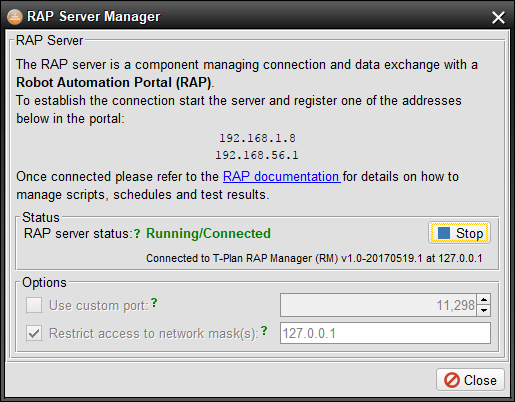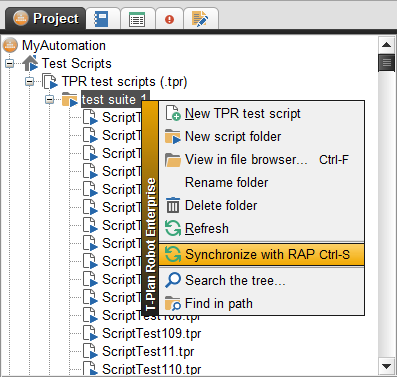rap
RAP Server
IMPORTANT: This document describes obsolete RAP2 connectivity which was removed in Robot v7. It is here for backward reference only. The feature was replaced with the RAP3 and RAP Agent products. |
|---|
Contents:
1. Overview
2. Connecting To RAP Portal
3. Data Synchronization
1. Overview
T-Plan introduced the Robot Automation Portal (RAP) product in 2016. It is a web portal allowing to monitor and manage T-Plan Robot Enterprise driven automation over the TCP/IP network (internet and/or intranet). For details see our web site.
To support communication with the RAP portal the T-Plan Robot Enterprise v4.2 delivered the RAP Server component. It is a TCP/IP server which communicates with the RAP portal. The functionality was significantly improved in the 4.3 release to address the new RAP generation.
2. Connecting To RAP Portal
To verify whether a Robot host is eligible for monitoring through RAP check that:
- T-Plan Robot 4.3 or higher is running on the Robot host with the RAP server on.
- The Robot host must be visible over the TCP/IP network and it must allow communication through the RAP port (no firewall blocking). A static IP is recommended.
To start the RAP Server perform one of the following:
- Specify the --rapserver CLI option to make the server start on the Robot start up,
- Select the Tools->RAP Server Manager menu item in the Robot's GUI and click the Start button.
To connect the Robot host to the RAP portal register the Robot host in the web UI as:
- To add Robot running on the same machine as RAP use localhost or 127.0.0.1
- To add a remote machine use the machine name (e.g. myrobot, myrobot.mydomain) or its IP address (e.g. 121.234.11.3).
- If the RAP server port was customized through the --rapserver option add the port number after semicolon (e.g. myrobot:12345, myrobot.mydomain:12345, 121.234.11.3:12345).
Once registered the portal will establish a TCP/IP connection to the RAP Server running on the Robot machine.
Security Considerations:
As of Robot 4.3 the communication between Robot and the RAP portal is not encrypted. That is why it is recommended to use this set up only in trusted networks. To improve the security restrict the access to the Robot server through the IP or subnet mask (see the --rapmasks CLI option). Future versions of RAP/Robot will deliver SSL encryption. Should you be interested in this option please ask our support for the current status.
3. Data Synchronization
The RAP portal works on top of a relational database and stores two categories of data:
- Information about Robot projects, workitems and scripts (called "work items" in the RAP terminology). The database does NOT store the script code (TPR of Java).
- Results and reports ("results")
Deletion of any records in the RAP portal removes them from the database only. It will NOT affect any data on the Robot host, such as projects, workitems, scripts or results (report files).
There are three ways to export work items to the RAP portal:
- Execution of a script or a workitem while connected to the portal will export the item to the RAP database.
- Use the --rapdirs CLI option to make Robot synchronize work items at the specified file path(s) on the start up. This option is suitable where the GUI can't be used, for example on headless environments or when starting Robot remotely from a terminal (telnet, rsh).
- For manual synchronization in the GUI right click a project, a work item (a script or workitem tree node) or a relevant folder node in the Project View and select the "Synchronize with RAP".
Results are being exported as follows:
- RAP records only results generated from the moment of registration of the Robot machine in the portal. Export of older results is currently not possible and is planned for a future release. Ask our support for the current status should you need it.
- Executing work items export the results to the RAP database in real time as long as there's a connection with RAP.
- When the connection to RAP gets interrupted the results are re-synced once the it gets re-established. This may take a while because it requires to search for and parse the reports (XML/HTML) from the local file system. The file synchronization is one way only (Robot to RAP) and deletion of report files will not affect the data in the database. If the look up takes too long or if you experience hard drive performance spikes shortly after the RAP connection please clean up the old reports.
- Look up of older results works as follows:
- Robot 4.2 can look up results of an older script execution only if it produced an XML report, i.e. when it called the Report command with an XML file argument.
- Robot 4.3+ in addition recognises results from scripts which produce only HTML report or even no report at all (the result is in this case read from the execution log file). This works only for HTML files produced by Robot 4.3+.



